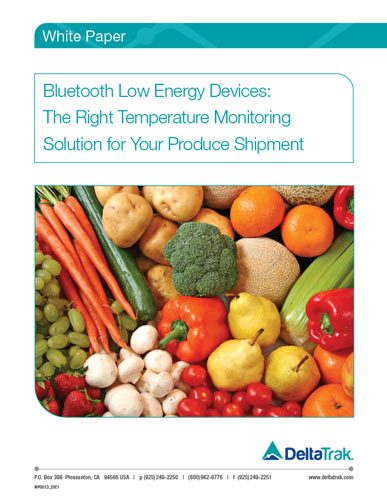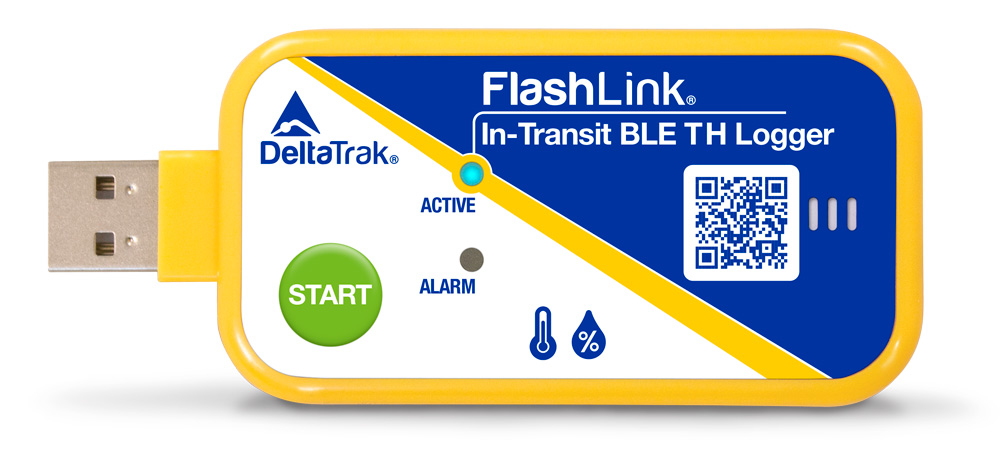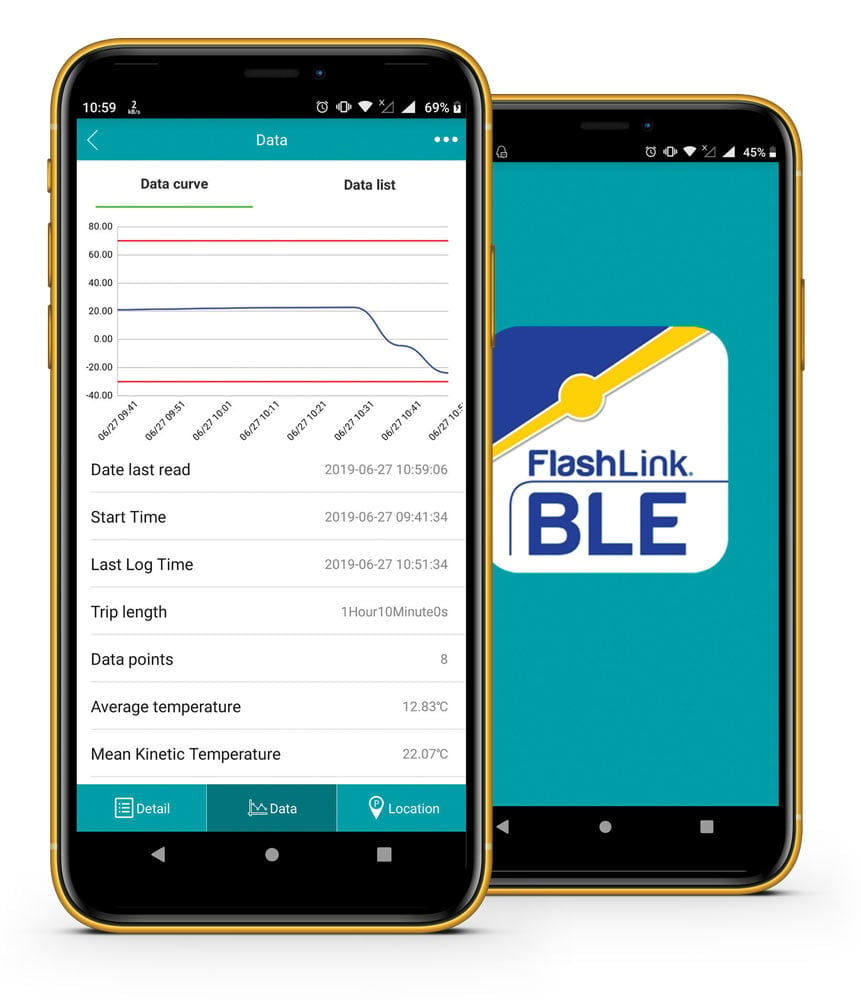 Download PDF
Download PDFIt’s a new year, but those in the food industry walk into it with an age-old problem – how to get food from point A to point B before it goes bad.
In the days prior to refrigeration and rapid transit, people were extremely limited in terms of the methods available to preserve food while moving it from one place to another. Of course, today, with the growth of commerce, the burden of keeping food fresh during transport is not only a public health issue, but a legal one. Each year, some 48 million Americans become ill, and 5,000 die because of foodborne pathogens. In response to such tragedies, regulation was established to prevent consumer illness, such as requiring that food be kept at temperatures below 40°F during transport. FSMA (the Food Safety Modernization Act) signed by President Barack Obama in 2011, focuses on preventing foodborne illness by requiring specific measures when transporting food by train, boat, aircraft and truck. Starting on April 16, 2017, shippers, loaders, carriers and receivers with at least 500 employees (and motor carriers) and $27.5 million in sales are required to comply with FSMA. (For smaller entities, the effective date was April 6, 2018.)
Refrigerated Food Transport
Refrigerated transport was created in large part to address the needs of food companies. In 1867, J.B. Southerland patented the refrigerated railroad car, a rudimentary system which utilized large blocks of ice and outside air to cool products being shipped. In 1949, inventor Frederick McKinley Jones patented a refrigeration system which enabled shippers to move food via truck. Thanks to Jones’ contribution, the trucking industry would go on to have an enormous impact on food transportation, as food was delivered over much longer distances than before, and at much faster speeds. With his roof-mounted cooling system, Jones co-founded Thermo King, a manufacturer of transport temperature control systems which has become an international brand.
Refrigerated transportation takes the following forms: truck, train, cargo ships, reefers and air. With the advent of the interstate highway system in 1956, the trucking industry saw massive growth. An obvious result was that transport of food over long distances was much faster than before.
The Necessity of Transporting Food
Although it utilized an incredibly simple process for keeping food cold, the early refrigerated train was instrumental in the expansion of interstate food sales. Commodities produced in one region of the country could be transported to consumers in other areas. People were able to enjoy produce from other geographic regions, and although meat was produced primarily in the Midwest and the South, it could now be shipped all over the country.
Global trade has increased substantially in recent years, resulting in the need to transport food over longer distances. The ability to move perishable products over a wide area means that many developing countries are able to participate in global commerce. In the United States, for instance, imported commodities include crabs, lobster and several varieties of fish, fruits such as bananas, pineapples and blueberries, as well as nuts and vegetables – the majority from Mexico. The U.S. imports red meat from New Zealand, Uruguay and Australia. Providing variety to consumers, at a reasonable cost, is the driving force behind importing these foods.
Food Transport Issues
Perishable food must be refrigerated or frozen prior to shipping for the prevention of unsafe bacteria and pathogen growth. However, it is important to note that different products require different temperature parameters. Guidelines have been established, and the range of temperatures is quite extensive. For instance, the recommended temperature for bananas is 56-57°F, but for cabbage, the suggested temperature is 32-36°F. For cheese, a temperature of 45°F is ideal. If cooled to under 26°F, poultry may be hard-chilled, which extends its shelf-life by several weeks. Typically, fresh meat and poultry must be delivered to the retailer within two days.
Keeping food at the right temperature during transport is not always easy, when consumer demands require that food be transported greater distances than in earlier decades. Studies of land transport show that, where some commodities are concerned, the distance from production to retail can be as many as 1500 miles, which is definitely far enough for temperature excursions to occur.
Not only do longer distances create problems when it comes to preserving perishable goods, it has also been observed that location within a pallet, as well as the location of the pallet within a truck or container, can pose a considerable challenge. The type of air delivery system – top-air or bottom-air – can also cause inconsistencies in product temperature. The way products are loaded onto a truck (load patterns) affect air flow and cooling as well.
Improper vehicle maintenance is also a culprit because it can cause temperature fluctuations resulting from leaky roofs and door gaps, as well as condensation and ice build-up.While air transport is an effective solution for high-value products, especially those with a short shelf-life, it comes with its own set of challenges. Not only can air transport be cost-prohibitive, but a considerable amount of time is actually spent in travel “down-time”, where product is either in route to and from the airport, on the tarmac waiting to be loaded or unloaded, or in airport storage (some airports provide cold storage).
These issues and others ultimately create spoilage, which is the greatest concern facing perishable food producers. Managing temperature during transport is one of the most effective ways to prevent spoilage.
Implications of Food Loss and Waste
The costs of food spoilage are great - affecting growers, retailers and consumers. Each year, approximately 1.3 billion tons of the food that is produced worldwide is either lost or wasted. Loss occurs at the post-harvest and processing levels (most often in developing countries); waste typically occurs at the retail and consumer levels. For myriad reasons, industrialized and richer countries experience the greatest food waste. One billion tons of food loss/waste equates to a staggering $900 billion. Of all discarded food, produce accounts for the largest percentage.
Bluetooth Low Energy In-Transit Logger – The Perfect Solution for Produce Shippers

Produce growers and retailers are preoccupied with many issues related to their business. Innovative and reliable temperature monitoring solutions offer peace of mind, by helping to ensure that products arrive in good shape. One temperature monitoring option for the produce industry, in particular, is a Bluetooth Low Energy logger. Most people are familiar with the term Bluetooth, but tend to only associate it with the wireless earpiece connected to a smartphone. However, Bluetooth is not a product. Rather, it is the wireless technology which connects the earpiece to the smartphone. It works by using radio signals to connect two or more devices, creating personal area networks (PAN) (or tiny networks) called piconets.
What has made Bluetooth such a revolutionary technology for connecting devices? “The big draws of Bluetooth are that it is wireless, inexpensive and automatic.” (C. Franklin, et al, “How Bluetooth Works,” Howstuffworks.com, November 8, 2019.) It also does not require “line of sight”. To get an idea of how line of sight works, consider the television remote. Remote controls, whether for televisions or toy cars, use infrared technology, which requires that two devices be in close proximity to one another, with nothing between them to interrupt the signal. Try standing in front of the television while someone is attempting to change the channel using the remote. It won’t work. The other unique benefit of Bluetooth technology is that it employs frequency hopping. The signal rapidly moves from one radio frequency to another to limit interference and interception. The first Bluetooth version was developed in 1999. Between 2000 and 2008 a plethora of products - from headphones to televisions - were integrated with Bluetooth technology.
Bluetooth Low Energy (BLE) was adopted in 2010. BLE was developed for three primary purposes: 1) use the least power possible; 2) minimize delays; 3) integrate the largest variation of device types. This newer technology transmits information in short packets, transferred at 1 Mbps. Data is transmitted at regular intervals, instead of continuously, which extends battery life. These devices use one-tenth of the power that classic Bluetooth devices use. In order for Bluetooth Low Energy technology to work, there must be a central device and a peripheral one. The peripheral device broadcasts (or advertises) that it has information to transmit and the central device scans and establishes a private connection (or piconet). The data is transferred and the peripheral returns to sleep mode until it is time to transmit again, which reduces the amount of power being used. Energy consumption and cost of BLE technology has been reduced as a result of going from 79 1-MHz wide channels (classic Bluetooth) to 40 2-MHz wide channels. The speed of BLE technology is another powerful benefit, taking as few as three (3) milliseconds to establish a connection and transfer data.
A central device, such as a smartphone or computer, processes the data that is collected by the peripheral. Temperature monitoring is the perfect example to illustrate this exchange. The data logger is the peripheral device and the smartphone (or computer) acts as the central. The logger records the data and the smartphone processes and displays it, enabling it to be read by the user. Bluetooth Low Energy is, perhaps, one of the best technologies for wireless sensors such as data loggers because “...it offers ease of compatibility with Smart Ready (smartphones, etc.) devices”. (Bluetooth Smart and Smart Ready Markets”, Markets and Markets.com.)
The energy efficiency of BLE makes it ideal for the Internet of Things (IoT), in that devices can remain connected for longer periods. The Internet of Things is the “next wave of mainstream tech...will enable the connectivity of your everyday household devices (like washing machines, cooker, toaster, kettles, etc) to one another and to the internet.” [M. Afaneh, “Bluetooth Low Energy (BLE) and the Internet of Things (IoT)”, April 26, 2017, LinkedIn.] Some of the more popular products that utilize BLE are Fitbit, Apple Watch, and heart rate monitors. Up to 20 devices can be connected simultaneously.
Combining Bluetooth Low Energy technology and 30 years of ingenuity, DeltaTrak introduces The FlashLink In-Transit BLE Temperature and Humidity Logger, Model 40910. This new PDF logger not only monitors temperature and location, but also humidity. As previously discussed, managing temperature is one of the most effective ways to mitigate losses, which can be extremely costly. Temperature monitoring devices are crucial because they record all excursions, as well as the length of each excursion. Knowing how long a shipment was outside the prescribed temperature range, and how often, helps product shippers, receivers and other stakeholders to make essential decisions.
One of the best features of Model 40910 is that users can observe shipment conditions, and have the assurance that the whereabouts of their cargo is visible at all times.
Tracking humidity is important because, if not managed, it can cause substantial cargo damage. In a produce shipment, where the environment is too dry, water loss can occur, causing mold and decay. According to the USDA in Protecting Perishable Foods During Transport by Truck (2008), “Relative humidity... is the percentage of water vapor in the air in relationship to the saturation point of the air at a given temperature.” The ideal RH to prevent moisture loss in produce is 85-95%. Roughly 10% of cargo is discarded as a result of moisture-related damage called “container rain” or “container sweat”. This is the build-up of condensation on the walls and ceiling of a shipping container that drips onto the cargo. Condensation can damage product and packaging, increasing the financial impact of the loss.

Data is stored in DeltaTrak’s cloud-based application. With our web app, decision makers can wirelessly display on a smart device a PDF report of the trip data.
Devices that monitor temperature, location and humidity present a detailed history of a shipment. Possessing this kind of information puts decision-makers in a position of power. In other words, knowledge is power. What does this power look like? Having the data to bring a liability claim, when necessary, puts someone in a position of power. Having the information to reject a shipment, if necessary, is also a power position. Being in a position of power is crucially important, when it comes to high-value loads, which can easily be worth $50,000 to $50 million, depending on the product being shipped.
The ease of viewing trip data from distances up to 65 feet, without device retrieval, allows shippers, receivers and other users to see (and share) data at every point along the cold chain. This feature is especially useful because keeping vehicle and container doors closed until the final destination has been reached is essential for retaining optimal climate conditions.With the belief that our customers appreciate flexibility, this logger has been equipped with features that enhance its versatility, such as the ability to view reports in graph or table formats, from either the app (iOS and Android) or a PC (using the built-in USB port). Likewise, users can program alerts for either email or text transmission.
Conclusion
Refrigerated transport has empowered food producers to keep product free of deadly pathogens while moving it from one place to another. Inventors like J.B. Southerland and Frederick McKinley Jones transformed an industry through innovation and responsiveness. In the same way, DeltaTrak seeks to provide solutions that improve our customers’ businesses by enabling them to serve their customers better. We help our customers adhere to regulations by creating high-quality and reliable products. Wireless connectivity, versatility and ease of use qualify the Flashlink In-Transit BLE Temperature and Humidity Logger as an all-in-one solution. This logger is but one example of DeltaTrak’s ability to respond to and exceed our customers’ needs.
References
D. Fairfield, “What’s required in FDA’s FSMA food transportation rule?” Feed, Newsletter, National Grain and Feed Association, May 25, 2017. [Online]. Available: https://www.ngfa.org/newsletter/whats-required-fdas-fsma-food-transportation-rule/
Dr. J. Rodrigue, et al, “The Cold Chain and its Logistics,” The Geography of Transport Systems: The spatial organization of trans-portation and mobility, 2020. [Online]. Available: https://transportgeography.org/?page_id=6585
H. Manaadiar, “The Essential Guide to Cargo Damage,” Shipping and Freight Resource, October 11, 2017. [Online]. Available: https://shippingandfreightresource.com/the-essential-guide-to-cargo-damage/#
J. Aurora, “List of Foods Imported Into the U.S.,” Classroom, June 25, 2018. [Online]. Available: https://classroom.synonym.com/list-of-foods-imported-into-the-us-12080392.html
S. Snapp, “How to Best Understand Your Refrigerated Transport Options,” Brightworkresearch.com, January 7, 2017. [Online]. Available: https://www.brightworkresearch.com/fourthpartylogistics/2017/01/best-understand-refrigerated-trucking-options/
S. T. Hammond, et al, “Food Spoilage, Storage, and Transport: Implications for a Sustainable Future, BioScience (American In-stitute of Biological Sciences, Oxford Academic), August 1 2015, Pages 758-768. [Online]. Available: https://academic.oup.com/bioscience/article/65/8/758/240222
T. Brown, “How One Man’s Invention Changed Food Access World-Wide,” U.S Department of Agriculture, February 11, 2017. [Online]. Available: https://www.usda.gov/media/blog/2012/02/21/how-one-mans-invention-changed-food-access-world-wide
“Food Distribution”, Food System Primer, Johns Hopkins Center for a Livable Future. [Online]. Available: http://www.foodsystem-primer.org/food-distribution/
“Food Safety”, Food System Primer, Johns Hopkins Center for a Livable Future. [Online]. Available: http://www.foodsystemprimer.org/food-safety/
“Guidance for Industry: Sanitary Transportation of Food”, U.S. Food & Drug Administration, April 11, 2010. [Online]. Available: https://www.fda.gov/regulatory-information/search-fda-guidance-documents/guidance-industry-sanitary-transportation-food
“Key facts on food loss and waste you should know!” SAVE FOOD: Global Initiative on Food Loss and Waste Reduction, Food and Agriculture Organization of the United Nations, 2016. [Online]. Available: https://twosides.info/includes/files/upload/files/UK/Myths_and_Facts_2016_Sources/18-19/Key_facts_on_food_loss_and_waste_you_should_know-FAO_2016.pdf
“Protecting Perishable Foods During Transport by Truck,” USDA, 2008. [Online]. Available: https://www.ams.usda.gov/sites/de-fault/files/media/TransportPerishableFoodsbyTruck%5B1%5D.pdf
“Transporting Meat and Poultry”, TheMeatWeEat.com, May 30, 2017. [Online]. Available: https://meatscience.org/TheMeatWeE-at/topics/article/2017/05/30/transporting-meat-and-poultry
“The basics of Bluetooth Low Energy”, EDN.com, October 14, 2016. [Online]. Available: https://www.edn.com/the-basics-of-blue-tooth-low-energy-ble/
“Classic Bluetooth vs Bluetooth Low Energy – A Round by Round Battle”, Semiconductorstore.com, September 24, 2014. [Online]. Available: https://www.semiconductorstore.com/blog/2014/Classic-Bluetooth-vs-Bluetooth-Low-Energy-A-Round-by-Round-Battle/860/